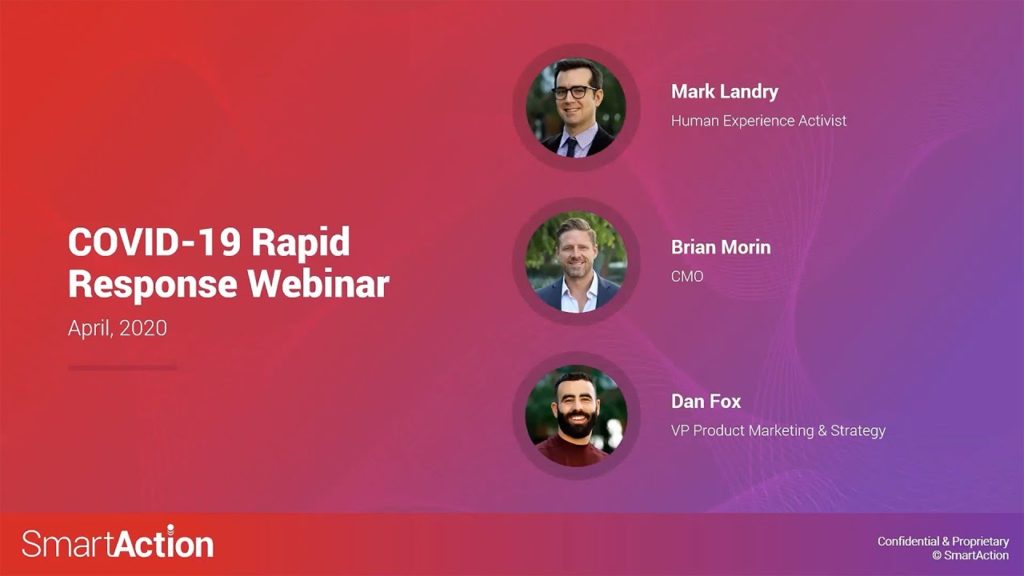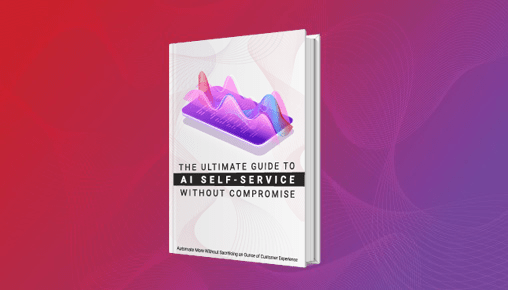#1 AI Tool for COVID-19 Operational Readiness

While some contact center call volumes have dropped, others have spiked with extended hold times. Contact centers need a rapid response solution that can answer commonly asked questions and even screen callers to create an escalation path.
SmartAction has quickly developed the industry’s most robust tool to address this problem and is making it available to at-risk organizations — no setup fees to customize to your business.
Examples:
- COVID-19 triage tool for healthcare providers
- Interactive FAQ bot for retailers and travel/hospitality
- Appt reschedules for service providers
Key Takeaways:
- Live demo of a Rapid Response Virtual Agent
- Intercept callers who want answers immediately
- Interactive chat to screen callers for escalation
- Voice to SMS to Chat channel switching
Watch This
Webinar

Mark Landry
VP of Product,
SmartAction

Brian Morin
Chief Marketing Officer,
SmartAction

Dan Fox
SmartAction Rapid Response Virtual Agent – the #1 AI Tool for COVID-19 Operational Readiness
On-Demand Webinar
Brian Morin: Well, good afternoon everyone. My name is Brian Morin. I’m the head of marketing here at SmartAction, welcoming you to today’s webinar. We’re calling this a virtual lunch and learn as we are all secluded at the moment and so hopefully trying to do at least a little something potentially to brighten up your day with a free lunch. Also, just doing something nice by supporting your local restaurants and takeout. That certainly could use a lot of support right now. So in that vein, we’re going to kick off today’s webinar talking about our response that we’re trying to do from our end carrying our sense of responsibility into this crisis as we have been inspired by what others are doing. We’re delivering what we’re going to talk about in a minute. A no fee rapid response virtual agent that we do believe is a necessary cornerstone to any business continuity plan for a contact center. With me today is Dan Fox is our VP of Product Marketing and Strategy here at SmartAction. Dan, good to have you with us today.
Dan Fox: Yeah.
Brian Morin: And as you’re settling in, we do want to make sure that you’ve just paid attention to the Q and A box and also the chat box so that way you can chime in and help drive this conversation as much as possible. We do have set content to talk about, but we’d like to be audience driven as much as possible. So while we still have attendees that are joining us, let me go ahead and just set the table for the conversation. We are a provider of AI powered virtual agents that use conversational AI to expand self-service over the voice channel, made them do over voice and chat. So as you can imagine, that’s put us right in the middle of this fight where we’re right in the middle of this with you with this pandemic doing our end on the AI front. We operate conversational AI for more than 100 brands from the Fortune 500 on down.
So we’ve been right there scrambling to help all of our customers react. Just as I know those of you listening in have been finding ways to react to this crisis. How do you maintain business continuity and for us it’s a using AI to do that for our customers. Just one example was very, very early. The state of Washington, they were the first issue, the shelter in place order, hit them by surprise. All of this hit all of us by surprise, but it hit the state of Washington first and that shelter and place order, we went into overdrive just to help with some of those businesses maintain continuity with automation. One example is a AAA club. They need to support their members on the road with emergency roadside assistance service obviously agent availability for them became a very quickly, short period of time limited and they needed to hand their CX to AI so we were able to step in for them as we’d help other AAA clubs.
Now that’s one specific example, but we’re not here to talk today about one-off applications for specific businesses. We’re here to talk about the number one request by far that’s come in from a number of organizations. All of them experiencing extended hold times for one reason or another, all COVID-19 related and those whole times are related either to an agent availability issue. It could be spikes in commonly asked questions or spikes in a very particular type of interaction. So in response, we have built out a solution that is very simple. We call it a… I say simple. There’s a lot of complexity to it as we’re going to show you in just a minute. But simple in a sense that we can scale it out very, very quickly. We called a rapid response virtual agent and it can be deployed in any environment and deployed very quickly.
It can be customized for any organization, whatever your specific need is to combat extended hold times that are COVID-19 related. So frankly it’s… Was that a coronavirus cough I just have right now? Frankly, it’s the number one piece of the puzzle that we feel that all organizations should have as part of their business continuity plan. In addition to the work from home front. This would really kind of take the AI front in that battle and the biggest piece is that we are giving this tool away to organizations who really need it. We are waiving all upfront professional service feeds. That means we’re not charging for any of the work to customize the application to your business. We’re not charging for any of the work to integrate into your environment. We’re not the Red Cross by any means, but we know that AI to some degree can be a Red Cross of sorts for contact centers.
So while this pandemic is in place, we just want to make sure that we’re shouldering our load the responsibility in this fight just like everyone else is doing. As we see all from Costco workers, all down to nurses. So now also with me today or who was supposed to be with me today is Mark Landry, our human experience analyst. He does a lot of our design work. He had to be pulled away this morning due to a very urgent project building that he’s doing with this rapid response virtual agent. We’re doing it for the COVID-19 national hotline, so. But Dan’s going to fill in and cover all of that in very short order. We’re going to get into an actual live demo of what this looks like and understand step-by-step what it means and how you might be able to apply it. Just for those that have joined in that maybe have no background or history of SmartAction.
They only need to know on screen is that we deliver AI powered virtual agents as a service. That means we bundle the full conversational AI stack, all the technology and bundle it together with end to end CX services. Everything needed to run it, the design, the build, the ongoing operation. Most of our customers will start in voice for the biggest ROI and then scale digitally to scale that experience to chat or text. When it comes to conversations with machines, particularly over the voice channel. They’re not easy. It’s not just design, build and poof you’re done. It’s why you do need a team of specialists committed to tuning the application week in, week out, pouring through data and analytics, listening to call recordings, meeting with your teams weekly on stats and objectives so we can constantly iterate and chase the most frictionless experience possible.
We integrate with every platform and we’d at least like to think this approach has been working for us as our customer reviews have made us the top rated solution on Gartner Peer Insights. That’s the only plug that I’m giving you about SmartAction. So should you by chance be in the market for expansion of self service capabilities. But what we’re here today to talk about today and what you’re here to listen about is what we’re doing in this rapid response solution to combat COVID-19 related hold times. We did a survey just three weeks into the pandemic as it was rising. I think at this time when we did the survey, only the University of Washington had a shelter in place order and everyone had the sense that one was coming soon for theirs. I’ll highlight just for questions from the survey. This is from near 50 customer service executives across different organizations and sizes.
But all the larger enterprise side asking what first, how did they rate the potential threat of COVID-19 to their contact center operations? If you look at the answer, 63% of those said it absolutely presented a high threat to their contact service operations. The follow up question to that, does your contact center have a best case plan or worst case plan in place now or are you in the process of planning them? Well, by half have planned solidly in place. The other half were trying to put those plans together on the fly. So as you can see, really hit organization’s hard on the business continuity planning front. We asked an open ended question. What technology initiatives is this driving and you can see if any of this resonates with you. These were an open ended question so we could get detailed responses. However, we found that all these responses fell into one of three very clear distinct categories. 26% said there was no technology initiative. They have everything that they needed, 30% were looking to expand self service automation either over chat or voice or both.
And then 44% said number one for them was implementing work from home technologies and capabilities so they didn’t suffer too much downtime with their call center. Last this question, what do you see as the actual threat to your operations? Well, as you can see it’s across the range of limited agent availability. The same as that relates to BPOs and could potentially suffer as we have seen and off shore like the Philippines. There is not for them even a work from home option with the lack of technology capability to do that and shoddy internets or the ability to have that space. Long hold times were expected by 51% of organization. So parlaying that in the kind of the fear of the coming whole times.
Well, this in front of you is just a small sampling. We would put more on screen if we had more room to fit. We have just been inundated from different organizations that are dealing with some of these whole time related issues. As you can see on screen. That’s just been an absolute killer for a lot of these organizations. My own son here, my own family broke his phone. We have T-Mobile try to use the online self-service tools to get a replacement. Of course in process of doing so there was a quote unquote “error,” please call into 1-800 and after calling in there was absolutely no way of finding our way to a live agent and continue to just get hung up on. So now my son stuck here in quarantine without a phone and trying to suffer his way through it and hopefully we can find a way to T-Mobile rep to relate that.
Well, what is the biggest reasons… What is the source, to these whole time issues? Well, one is obviously it’s the agent availability side, whether or not there’s even work from home capabilities or it might be relying on a BPO that doesn’t have work from home capabilities. The other is the threat of what does happen if some of that agent population goes down sick. And then the other element of this is this, any crisis creates a spike in commonly asked questions that don’t necessarily need human assistance, but they call in anyhow. Not a lot of folks are proactive about in advance of going in and reading FAQ, on your website, they just call in. Of course that takes up time and attention that needs to go from those that are more deserving. In other cases there might be one type of interaction and Dan will speak of in a minute that we’re resolving right now for Royal Caribbean where it’s particular interaction that never had high volume before and suddenly that one interaction has a lot of volume now and it’s beyond what agents can handle.
So what has been the real missing link? Why is this whole time spike? Why is it happening? Why were we not prepared for it as contact centers? What was missing? The missing link is here what we’re talking about today that we’ve been asked by a number to develop. Of course all of us should have seen this before, but the missing link is this layer between a caller and your live agents. Having that AI agent be able to essentially screen and help callers that don’t necessarily need human assistance. That’s we found going down one of two very common paths. One path is the commonly asked questions. You have the ability to dip into your FAQ, interact with a customer and be able to handle that, get them off the phone line to a channel switching experience. Have an interactive FAQ bot to handle what they’re asking about immediately instead of having to wait on hold or conversely either in addition or conversely it’s a screening tool.
The ability to triaged, to ask a number of questions to find out if in fact is this a call that should be escalated and then how do we get them into an escalation path to be speaking with a live agent. So now that we have identified what the problem is and identify what the missing link is to an effect, a contact center business continuity plan. We have Dan Fox who’s joining us today who played a large part in helping to develop this tool in a very short period of time. Very robust tool. Dan, you’re going to give us a live demo of this. So those that are listening in can get an actual touch and feel experience of what this looks like and perhaps understand how it might apply to their business.
Dan Fox: Yeah, yeah. Let’s jump into it. So what we’re going to show is, I’m actually going to… Brian, if you want to pause your screen share, I can pop up my screen and what I’m going to show is a mirrored version of my cell phone. What we want to show, as Brian alluded to is how we can deflect calls that are incoming and push them to alternate channels to provide alternate resources. So I think the demos going to be pretty self-explanatory. The one caveat I’ll mention is keep your mind open for what this platform is capable of. We’re showing a healthcare demo because we know we’ve talked to a lot of medical groups who are just faced with a huge influx of calls. But we’ll think about how this may apply to your own industry. We’ll walk through a few cases that we know about. So I’m going to go ahead and place a call, put it on speaker so you can hear it.
Diego Healthcare: Thank you for calling Diego Healthcare. We are experiencing a high call volume due to COVID-19 inquiries, so hold times, maybe longer than usual. If you’re calling with questions about the virus, I can text you a link to a COVID-19 answer center where all of your questions can be answered 24 hours a day. Would you like to take advantage of this feature?
Dan Fox: Yes
Diego Healthcare: I have your phone number ending in 1251. Would you like me to text the link to this number?
Dan Fox: Yes.
Diego Healthcare: Great. You should receive the text momentarily. Please follow the instructions in the COVID-19 answer center. If you still have questions after using the answer center, please call back and one of our agents will assist you. Goodbye.
Dan Fox: So what we showed hear is one example where we actually initiated a hang up directly from the call. So this user said they wanted to try out the FAQ center and we automatically hung up the cost savings of that as you can imagine, would be significant. Alternate arrangement would be actually keeping them on the line to make sure that the service did the right job for them and then keep them, if they want to jump back in and they still needed to talk to an agent. But we do have some tricks up our sleeve for how we can move this conversation into a live agent if necessary. So as you can see here, I got the text message that says hello from Diego Healthcare. Click on this link. So I’m going to go to this link and what I’m going to get is a rich web chat session, which could be initiated from any web browser on any device as long as it’s internet enabled.
So it says, welcome to the answer center. Please select a question for more information or type your question below. So from here what I can do is go with any of these three top options right here. Or I can say I have another question which I’ll show you in a second. So let’s just go to how is it treated. What I’m going to get, as you know, a simple standard answer that says there’s no approved medication to treat right now. From here I’ll get the remaining questions that I can ask or I can say I have another question.
So from here what I can do is actually access a knowledge base so I can say is there a vaccine available? What’s happening in real time is that question is being submitted to three knowledge bases. Who are going to return the highest confidence rate and deliver us the best answer for this question. So it says currently there is no vaccine available. Did that answer my question? Yes. All right. Here’s another link in case I want more information from the CDC. Let’s say I want to ask another question. So this time I’m going to say what are the symptoms?
So this is where we from it an FAQ bot into a real screening bot. So here’s the symptoms. But it says, would you like to take our self-assessment? Let’s say yes. What I’m going to get here is the start of a few questions to help screen whether my situation is urgent or whether I needed to talk to a medical advisor or whether I’m okay and to just wait and standby. So let’s say I have not tested positive and have I been exposed to somebody? Let’s say no, who knows. Are you experiencing any of the following symptoms? So let’s say I am experiencing two of them. So here I actually get a checklist and I can select as many that apply. Let’s say fever and cough. Let’s go ahead and submit. Are you in immediate distress? So in this question, if I answer yes, what it’s going to tell me to do is call 911 immediately.
But for this example, let’s say no. So here it says, “Although you’re not in immediate distress, since you are showing symptoms, you should talk to a medical professional.” Tells you how long the way it is using a real time data access to talk to a doctor. From here, let’s enter in my contact information. This is what I alluded to earlier when I said that we have a tricky way to get right to a live agent if necessary. So what I’ve done here is actually submitted my information, which will get submitted back to Diego Healthcare, our fictional company. Which is then going to initiate a call back, at which point when the whole time is over and an agent is available, I’ll actually get a call to that cell phone number that I called from. So that’s one use case we can hop back into the presentation here.
But what we wanted to show in that demo is how we can move seamlessly from a voice experience to an SMS experience and then of course back into a chat bot experience. So this is a great example from healthcare, both an FAQ bot or a screening bot. Let’s walk through a few more examples to kind of show how else this could apply.
So the first one we’ll go through is actually one we’re working on with a major cruise line operator who, if you’ve been following the news, as I’m sure you can imagine. All cruises are now canceled for the time being. So what this cruise operator is doing is actually issuing gift certificates through email for these canceled cruises. What users can do is now call and use that gift certificate that they received to book a new cruise later in the year or next year. Today that functionality didn’t exist for you to rebook automatically using your gift certificate. We’re actually that for them. So understanding their issue is, all these people are calling up to apply these gift certificates. So now we built a voice-based virtual agent for rapid response. So when someone calls the company, they’ll be able to automatically go through the process of applying these gift certificates and actually booking a new cruise.
So let’s jump into the next one here. Another huge one that we’re hearing from the market is appointments that are being canceled for service providers. This also applies within the medical space. This happened to me today. I had a DMV appointment. It obviously got canceled. I got a text message from the DMV saying your appointment is canceled. Okay, so now if I want to go rebook one, I have to go back to the DMV website, find a time that’s available. It’s a chunky process.
What we want to do is offer a virtual agent experience, not just reactively like you’ve heard, but actually proactively. So we can send a text message just to anyone who may be affected to say, “Hey, your upcoming appointment, it is still happening. Do you want to change it or cancel it?” And then what they can do through conversational SMS is just change their appointment, get new times that are available through a real-time data integration and then get on their way. So not only did we provide them an alert, but we provided them a virtual agent experience, which allowed them to complete a transaction, which in this case would be a complete reschedule.
The last example will kind of mention is in retail, which is greatly impacted from the merchandise inventories because of how many delays there are in getting these shipments out the door. What we also came across is in store returns. A lot of retailers can’t do in sort of returns. This is kind of the example of an FAQ bot. So in this example of someone chatted with them in Facebook Messenger. We get intercept that Facebook message with a rapid response virtual agent that could apply the appropriate messaging to say, “Hey, we’re extending our return policy for in store until further notice.” But also give them an option to mail in their order for return at which point we can go through a conversation to provide them a shipping label so they can just return it in the mail and they don’t have to come in store at all.
Since we created this presentation, we actually had another one pop up, which is really interesting for a certain state unemployment line. Who’s, as you can imagine, they’re getting swamped right now with people trying to complete applications to receive unemployment benefits. It’s a 25 question survey that is done with live agents today. Right now the live agents are just not available to answer these calls. What we’re implementing in the next few days is an application where, just like you heard in the demo, if someone calls to complete an application, we’re going to send them a link to go through the application through a rich web chat session. Where they can complete all of the questions in that application and then we pass that information back to the state and they can follow up with everyone who completed an application, which will allow them to save upwards of 10 to 20 minutes for every application that they have to complete.
So just to lay out what we mean when we refer to a rapid response virtual agent, there’s a lot of flavors of this like you just heard. But to walk through the steps, step one, intercepting callers with specific messaging, sending customers a text link and then offering a chat bot session from the SMS. So we can jump to the next one here. What we want to do is just show how seamless this can be. I think five, 10 years ago a customer would be like, “Hey wait, what do I do? I got to go to SMS.” Now it’s seamless. People are expecting these kinds of experiences. So if you’re able to cross channels in a really seamless way, like you saw in that demo. Even though we hit three different channels, the user experience is super joined together and you’re guiding the customer rather than leaving them in the dark.
So in this, what we started out as offering the custom greeting, offering them a text example. That example that you heard in the demo, we just say do you want to call the number that you’re calling from? If I was calling from a landline, what I could have said is no and then offered the cell phone number that we want to send the text to. And then step two, getting the texts like you saw, which contains a link to get you over to a chat bot. The one caveat I’ll mention here is if it’s a simple transaction, maybe you just do this all in SMS. And then you don’t offer the web chat experience and you just ask a few questions in SMS, which is great because it’s a very accessible channel. A lot of people are comfortable with it.
But obviously you don’t have as many capabilities as you do in that chat bot example that you’re seeing here where you know you have buttons, you have yes nos. You can kind of guide the user through the right experience. As Brian mentioned before, there’s two flavors of this. Just providing the FAQ like you all saw at the beginning of the chat and then screening, which is like, “Hey, we want to complete an application, we want to complete a process.” You’re guiding the user to get to the right answer.
Brian Morin: So Dan, I had a question that came up earlier on just architecture and integration. I held off on that knowing these slides were coming. In fact there’s a couple of different ways that this can be implemented in their environment isn’t there.
Dan Fox: Yeah, totally. So when we’re talking about the voice portion, a lot of this is flexible, so keep your mind open. But what we wanted to show is that there’s two seamless ways that you can get this done. The first, probably not the best user experience as the next one, but in this one, what we’re saying is keep everything in place. All you do is have your IVR vendor or if you have the ability to do it on your own, just a front end, your own IVR with a message that says, “Is your question unrelated to covert 19?” And then they press one and then we would do a soft transfer via likely PSTN unless you have seven plays. And then that call gets transferred into our application and we greet the customer and say, “Hey, would you like us to text you a link?” And then if we need to move them to digital, then we allow them to do so.
So the next part is probably the more optimal, which is sitting in front of the IVR where all we would do is set up a soft transfer from your current toll free number. Where the customer calls in there’s a soft transfer immediately to us and we front end the call. So we say, “Hey, thanks for calling company X. Is your question related to COVID-19.” And then offer the experience that you heard in the demo. Offer them the digital channels.
If for any reason they don’t want to engage with the virtual agent or they’re calling about something else, then we do a soft transfer back and that can either go directly to your live agents or you can put them into your existing IVR and we can do that transfer likely via PSTN. So two ways to get about it, both relatively easy to set up, both offer their benefits. If there’s another one we’re missing let us know. The platform is pretty flexible and maybe it doesn’t start in voice. Maybe it starts in chat or it starts in texts. There’s multiple ways you could go about doing this.
Brian Morin: Thanks Dan. Now we put this slide in just at the very end to make a quick plug on why is it that customers choose SmartAction if you happen to be in the market you’re expanding your AI automation capabilities from simple to complex transactions. Don’t think I need to cover this. I think you give that plug on the about us overview slide. But the only way to think of us is we’re not just a technology provider. We’re not in this just for selling software licenses and then you know pushing you out and the ship off to sea with a couple of oars and saying good luck. We actually do the work for you on your behalf. So we step in more of a partner who’s delivering both the technology and the NDN CX services to actually manage your CX for you and we will just jump into next steps because I know we’re out here at the bottom of the hour and we want to field any questions.
A couple of that have come in so far that we’ll get to an any other questions that you may have that you didn’t ask. Please just type them into the Q and A box or put them into the chat box and we’ll answer here. Regarding next steps, I mentioned this on the front, we’re doing something very different and special with this offer. We have stood up and built this application but we are delivering it without any upfront professional service fee. That includes all the work that goes into customizing the application to your need and to your business. And all the work to coordinate with your IT on your side to make sure that you are fully integrated and getting you up and running. Again, it’s just us doing our piece on the two acres that we own in AI where we know we can step up to the plate and try to do something socially conscious in this time.
As far as your actual fees that are related to ongoing fees on usage, we’re passing those long at half costs and you can just get in touch with us to see what those are based on volumes. So if this is something that you are interested either for your environment or perhaps you know a colleague in another contact center who might and there are combating whole time issues. You see a way to contact us info@smartaction.com just send an email there and somebody will reach out on our behalf and get you started with maybe a demo on your own end, understand your business need and see if there’s a fit for what you’re doing.
As soon as this webinar is over, you will be getting a copy of the presentation. We’ll also include a link to this solution page that has the demo that Dan outlined and the moment that this renders, it takes a few hours. But once it has rendered it will be uploaded to our YouTube video and we will likely have somebody on our team socialize that link with you likely tomorrow. So that you have it as your own resource or perhaps you want to share with other stakeholders on your team, you will be able to do that.
So for those that did join, if you have a hard stop. We thank you for joining. We hope that you enjoyed lunch and hope we brighten your day a little bit. We will also encourage you if this is not something that you have an immediate need for, please feel free to visit our LinkedIn channel and look up SmartAction on LinkedIn. You can find this rapid response virtual agent offer that we’re delivering to the marketplace. If you don’t mind like, share, or comment. So it goes to your other colleagues that are in your network of professionals. So that this hits those organizations that might be a need for something like this. So Dan, one question that I am going to just kind of combine together. One is, how difficult is the integration? I think you’ve covered that a little bit in the reference architecture slides. But the other question here is, how long does it actually take to stand this bot up?
Dan Fox: Yeah, I think I’ll give the consultant answer. It could be as short as a few days. It could be a week. It kind of depends on how complicated what we’re building out. But our platform is built for speed, for this type of scenarios and we’ve mobilize the team around this so we’re executing as quickly as we can. So it wouldn’t be uncommon that we could get an application out the door in a few days.
Brian Morin: Well, so a good example is right now, I mean Mark was not able to join who’s one of our designers or oversees our design department at SmartAction. He’s right now working on this rapid response virtual agent customizing it for the COVID-19 national hotline. Maybe even from a timeline perspective, Dan, how long do you see that taking before it is stood up?
Dan Fox: Yeah, we started the application scoping out the application last night. We have something that’s being tested right now and we should be able to get out the door with reporting by the beginning of next week.
Brian Morin: Cool. Well, so I don’t see any other questions or comments at this time. So it looks like that we are free to close. Of course, you will receive that email from us as a follow-up with the link to the deck and the presentation. So we’re happy to oblige with any questions you have there or even on your end, if you have an initiative that you would like to take with us, you can see that at infoatsmartaction.com. We look forward to continuing the conversation with you. Dan, any final remarks on your end?
Dan Fox: No, I appreciate it everyone joining.
Brian Morin: Yep. Hope you enjoyed lunch and hope to be talking to you soon. Thank you everyone.





